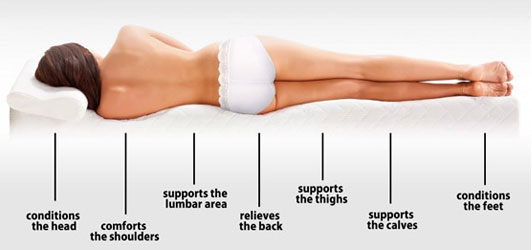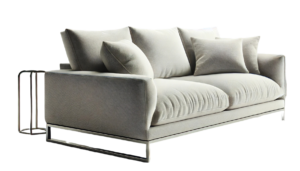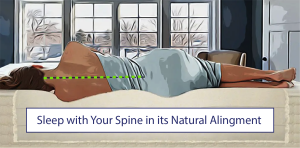A day doesn’t go by without us getting a call, visit or email from someone looking for a Memory Foam Mattress Topper. Here is one example:
“I have a memory foam mattress and I hate it. I have chronic back problems. My back has hurt so much more since changing to memory foam. I get hot when I sleep, so the way the foam heats up is not comfortable for me. I prefer to have a mattress with a memory foam topper. I know people who love their memory foams but it’s just not for me. I’m now looking for a better Memory Foam Topper because the one I bought online did not last that long. Can you help me?”
Ron S. – Markham, ON
So this customer likes memory foam toppers but hates memory foam mattresses. Others call looking for one or two inch memory foam to put on top of a spring mattress that is lumpy because it has lost its comfort zone.
As a matter of fact, the most frequent complaint that we get, about spring mattresses, from people that come into our showroom is that “my 20-year mattress has sagged prematurely after just 3 or 4 years.”

You should know that most Innerspring mattresses, that you find in stores, are made with low-density foam toppers that mat down after a short period of time. We call it fake comfort. It looks great and comfortable on the showroom floor but the comfort zone mats down quickly.
Once it does you are then sleeping on the springs which create uncomfortable pressure points on your shoulders and your hips. This, in turn, causes you to toss and turn restlessly throughout the night. Pressure points can also be created by sleeping on a spring or foam mattress that is too firm for your size.
Not all Memory Foam is Created Equal
All foam is not created equal and neither is memory foam. There are many different densities and compressions of memory foam that will determine how long the foam will last before sagging or softening up with use.
In addition to the type of memory foam that is used as a mattress topper, it is also important to have a good middle transition layer and a bottom layer for long-lasting support and durability. I can’t stress this enough, the three layers, in the right thickness and compression, work together as a system to give you comfort, support, and durability.
This is why I often tell people that they are wasting their money if they think to buy a one-inch memory foam topper, to put on top of your old spring mattress, will do much of anything to replace the three-inch comfort layer that no longer exists.
Since memory foam is usually very soft, you will go through it and feel the lumps of cotton felt, polyester fibre and light-weight foam that has bunched up or matted down underneath the mattress cover.
As for Ron, who emailed us above, your experience with a complete memory foam mattress or just a topper will depend on a number of things like the type and thickness of the memory foam used, what supported the memory foam and the core of the mattress that he put his memory foam topper on.
Unless you really know what’s inside or what you’re buying, put down that mouse and first come to our foam and mattress factory to get educated. If you want to buy a good mattress and sleep better, get to know your foam first.
Reasons for Buying a Memory Foam Topper
If you are curious about memory foam mattresses, why not try a memory foam topper first and see what you think. Here are some benefits to consider:
1) Relieves Pressure Points

When you lay down on memory foam, the material yields and adjusts to your shape, rather than forcing you to contour to it. Unlike springs and other materials, memory foam does not “push back” or place added upward pressure on your body.
2) Proper Back and Spine Alignment
The memory foam spreads your weight across the bed’s surface, contours to your body’s curves, and allows the foam layer under it to support your lower back and maintain your spine in its natural alignment.
When you are on a spring mattress, that has lost its comfort zone, your weight is typically concentrated on areas that contact the mattress like your: shoulders, hips and heels. For both back and side sleepers, this often means the lumbar area is not adequately supported. Lower back pain and muscle tension can occur without critical support.
3) Relieve and Prevent Pain
The unique combination of pressure point relief and support found in memory foam mattresses sets the stage for relieving current pain and preventing pain as well. According to reviews, the majority of memory foam mattress owners report reduced pain, especially in the back, hips, and shoulders.
The material is also a favorite of people with painful conditions like arthritis and fibromyalgia. By supporting correct alignment, contouring to the body and not placing added pressure on sensitive areas, sleepers’ bodies can experience optimal comfort. Reduced pain is also associated with better sleep, offering another benefit.
4) Different Weights Can Be Accommodated

Whether you weigh 220 pounds or 130 pounds memory foam mattresses can be made to accommodate couples of different weights. That way you can both get the right firmness that you need or want, based on your weight, back condition, and preference, and still sleep on the same mattress. Have it your way on your side of the bed!
5) Stop Motion Transfer
Movement can create a lot of motion in traditional mattresses, which can mean disturbed sleep for couples. This can be a particular problem for couples with different schedules and for light sleepers.
Another key benefit of memory foam is that the material absorbs motion and isolates rather than transferring it. When one person gets out of bed or rolls over, their partner hasn’t bounced around or jolted out of sleep. Memory foam combined with Contour Foam Pockets not only give you even better contouring and air circulation, but the channels also stop any transfer of motion from one side of the bed to the other.
6) Very Popular
Memory foam mattresses are the fastest growing sleep system since they were introduced to the industry in 1991. As awareness of memory foam and its use in mattresses spread, consumers began to take notice of the distinct benefits the material offers.
Growing popularity and innovation spurred a variety of manufacturers to enter the field. Today memory foam mattresses account for 26% of industry sales. Their popularity is growing rapidly and they are highly rated in owner satisfaction; especially, by consumers who have done their homework and bought the right stuff – thickness, type, density, proper layering and the heaviest grades available.
Final Note
In summary, those are some of the sleep benefits that come from memory foam. They may, or may not line up with the attributes as seen by the merchandiser, or the consumer. However, the uncomfortable, overly firm bed is still very much in vogue.
Consumers don’t really know what to look for in sleep products. They buy what they are sold and too many sacrifice long term value or comfort by jumping on the lowest price. On the other hand, educated consumers know that better quality sleep lies with foam and mattress manufacturers and designers, and their deeper understanding of true sleep attributes, and the ways to meet them.
Start every day with a good night’s sleep…
Sincerely,
FOAMITE INDUSTRIES INC.
R.C. (Bob) Dimas
Be the best that you can be by doing whatever is necessary to improve the quality of your sleep!



